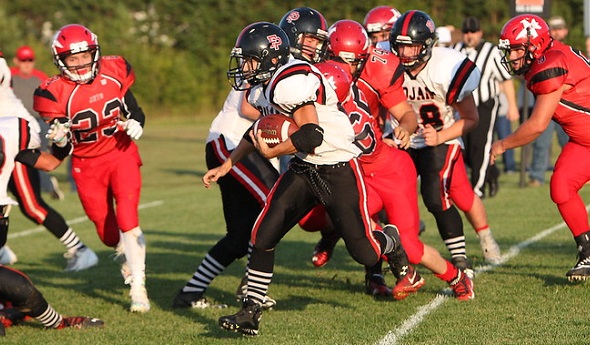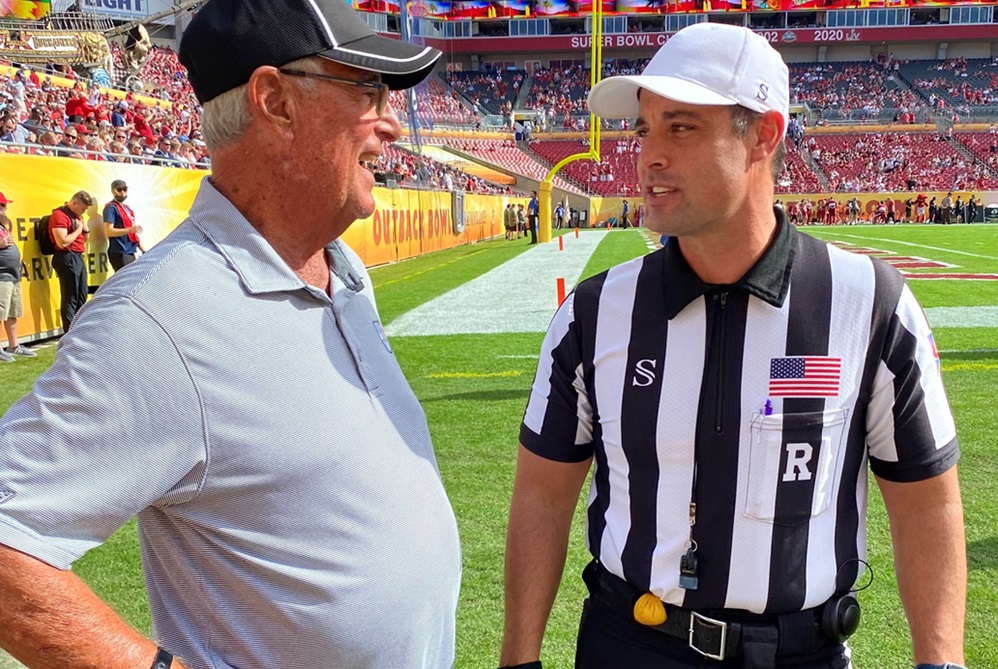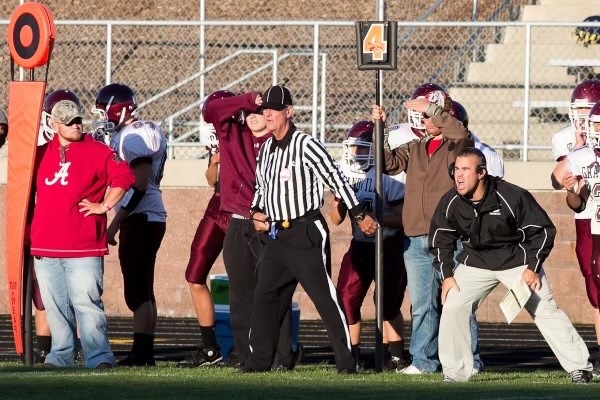
8-Player Takes Flight in Upper Peninsula
September 28, 2017
By Dennis Grall
Special for Second Half
ESCANABA – Three yards and a cloud of dust. That was the highly successful version of football applied by veteran Ohio State coach Woody Hayes as big bruisers dominated the game.
 It certainly is not the preferred style on the fields of 8-player football. Nope, this version is much more open-field and definitely more exciting, full of big plays and a ton of scoring.
It certainly is not the preferred style on the fields of 8-player football. Nope, this version is much more open-field and definitely more exciting, full of big plays and a ton of scoring.
Take Powers North Central as the prime example. The Jets have won the last two 8-player MHSAA championships with back-to-back 13-0 seasons, piling up yards and points in their first two seasons in the 8-player game with a large group of skilled athletes.
Their winning streak ended at 27 games earlier this season, but the style they displayed with exceptional athleticism led by Jason Whitens and Bobby Kleiman has caught on with many other programs.
The Upper Peninsula, at the forefront of the 8-player game due largely to decreasing enrollments, has been lighting up the scoreboards this year. Teams like Pickford and Cedarville, Rapid River and Stephenson, Ontonagon and Crystal Falls Forest Park are progressing with the same formula as North Central by featuring explosive offenses.
Citing some 8-player detractors who don't think the game is real football, veteran Cedarville coach Scott Barr said, "I don't think anyone can argue that it (8-player) has not been healthy for football. It has been healthy."
The game is thriving in small schools because the 8-player version simply has allowed football to remain in the athletic program despite shrinking enrollments across the state.
"It has allowed us to keep football," said veteran coach Steve Ostrenga of Rapid River, who led the Rockets into 8-player Finals in 2011 and 2013 and into the playoffs every season since making the switch after going 1-7 in 11-player in 2010.
"We did it out of necessity. We may have waited too long," added Ostrenga, recalling that last year of 11-player football when only one sub was available at several games.
Veteran Pickford skipper Josh Rader has an idea why the 8-player game has met approval at so many small schools. "It is a high-octane game. It is a lot of fun to watch," he said. "It puts a lot of pressure on defenses because it is such a wide open game. It makes it exciting for the fans."
No longer do fans have to squint and squirm in their seats to see what is happening among the goliaths in the line. Now the football is visible in the wide open spaces as skilled athletes display dazzling moves, whether the team favors the extremely popular spread offense or uses the more familiar run-oriented approach.
 "It is more a one-on-one oriented game now," said coach Ben Mayer of Ontonagon, whose program has consolidated with neighboring Ewen-Trout Creek, which yearly battled small player turnouts just to keep the game alive. Fifteen E-TC students are playing football at Ontonagon, with six on the varsity, highlighted by 6-foot-7 receiver Jacob Witt, who caught MHSAA 8-player record 24 touchdown passes last season.
"It is more a one-on-one oriented game now," said coach Ben Mayer of Ontonagon, whose program has consolidated with neighboring Ewen-Trout Creek, which yearly battled small player turnouts just to keep the game alive. Fifteen E-TC students are playing football at Ontonagon, with six on the varsity, highlighted by 6-foot-7 receiver Jacob Witt, who caught MHSAA 8-player record 24 touchdown passes last season.
"Without 8-player, we would have gone under a while back," said Mayer, who played for U.P. Sports Hall of Fame coach Bob "Cubby" Carlson at Ontonagon. He said the Gladiators were forced to use four freshmen and had 130-pound athletes on the line in past years.
"Football has changed a lot in the last four years," he said of the time since the Gladiators moved to the 8-player game. "The ball is in the air. It is fun to watch.”
Mayer said 8-player also enables his program to offer junior varsity football to younger students, instead of having them compete against older, bigger and stronger players with the potential to increase injuries.
"There is not as much violence between the tight ends now because we don't play in those tight spaces," said Mayer.
He also recalls putting "wildly undersized kids in the line against bigger schools with monsters from legitimate programs, with kids getting stepped on and squashed on.
"You do have a lot of choices in 8-man. I can put smaller kids somewhere and they will be all right, and we can still play football."
Ostrenga said it seems injuries, especially of the serious variety, have also seemed to decrease. "We used to hit a lot more in practice. Now we do a lot of teaching and drill work and conditioning," he said, adding MHSAA officials have been in the forefront of trying to reduce injuries with new regulations.
Ostrenga said in the 11-player version, many times it came down to "men playing against boys."
He did say, however, that under the 8-player game coaches "can tend to overuse a player. You get a really good athlete and use him as a crutch in a game."
Ostrenga said it took time to support the change to 8-player football. "I was against 8-man football at first. Now it has made me more open-minded and allowed me to become more understanding." He said 8-player athletes need to have speed, strength, balance and shiftiness.
"Some big guys can't move that well," he said, indicating this version of football requires more agile and nimble athletes to cover the wide-open spaces. "The big thing is understanding you have to get your athletes on the field. You just have eight guys on the field and you are (more) exposed. In 11-man you can hide someone. In 8-man, coaches will find your weaknesses."
Rader agreed, noting, "It puts a lot of pressure on the defense because the game is so wide open. There is a little different strategy. It is a disadvantage for the defense because (the field) is so wide open and there is not a lot of help. You want to take the advantage your offense has over the defense in one-on-ones.
"We like to run the ball and throw the ball, so our athletes can utilize the open field.”
Barr said 8-player quarterbacks are more difficult to contain than typical pocket passers. "They are more elusive," he said, recalling how the 6-foot-4 Whitens could take the direct snap, survey the field and decide whether to throw or run the ball himself.
In the 2016 MHSAA title game, Whitens ran 17 times for a record 352 yards and six touchdowns as the Jets beat Deckerville 58-22. The Jets ran for 469 yards that night.
"You rarely see teams ground and pound," Barr said of the8-man game, noting he began to rely on the spread offense in 11-player football as he tried to figure out how to match up with the over-powering tailback-oriented rushing attack of perennial power Forest Park, which began playing 8-player football in 2016.
Barr said the kicking game is of vital importance now and that secondary tackling is a tough transition because of the explosive offense athletes.
He said "the hybrid player who has size and speed" is featured in 8-player "and it can eliminate the real big kids," which he said are seldom a factor for small schools anyway.
Another plus for the 8-player game comes in scheduling, where Class D schools no longer have to face larger Class C programs and can also find opponents in northern Wisconsin, which also has declining enrollments.
Bark River-Harris and Lake Linden-Hubbell are the only Class D schools still fielding 11-player football teams in the Upper Peninsula. Three other schools, Class D Wakefield-Marenisco and Bessemer and Class C Ironwood have formed a cooperative program, Gogebic Miners, for football purposes.
 Denny Grall retired in 2012 after 39 years at the Escanaba Daily Press and four at the Green Bay Press-Gazette, plus 15 months for WLST radio in Escanaba; he served as the Daily Press sports editor from 1970-80 and again from 1984-2012. Grall was inducted into the Upper Peninsula Sports Hall of Fame in 2002 and serves as its executive secretary. E-mail him at sportsdenesky@gmail.com with story ideas for the Upper Peninsula.
Denny Grall retired in 2012 after 39 years at the Escanaba Daily Press and four at the Green Bay Press-Gazette, plus 15 months for WLST radio in Escanaba; he served as the Daily Press sports editor from 1970-80 and again from 1984-2012. Grall was inducted into the Upper Peninsula Sports Hall of Fame in 2002 and serves as its executive secretary. E-mail him at sportsdenesky@gmail.com with story ideas for the Upper Peninsula.
PHOTOS: (Top) Crystal Falls Forest Park downed Powers North Central 66-58 in Week 2 as the teams combined to score more than 100 points for the third time in two seasons. (Middle) Ewen-Trout Creek’s Jacob Witt, here against Carney-Nadeau last season, caught 24 touchdown passes in 2016 and is playing as part of a co-op team with Ontonagon this fall. (Photos by Paul Gerard.)

VanderVelde Officiating Tree Branches Into 2nd Generation, Top-Tier College Football
By
Steve Vedder
Special for MHSAA.com
February 28, 2025
Mike VanderVelde always knew the apple wasn't going to fall far from the tree.
The longtime West Michigan football and basketball official correctly guessed that his son, Michael, who had accompanied his father to countless Friday night football games before he was even out of elementary school, would eventually pick up the family mantle of officiating. VanderVelde said he saw in his young son many of the key attributes an official must possess: a keen eye for details, an overwhelming desire to improve, patience and a love of sports.
Put it all together, and VanderVelde has seen his son evolve into one of the nation's top NCAA football officials.
"I think it was just like with any kid, he liked the competition," said Mike VanderVelde, who retired three years ago at the age of 78 after officiating in the Grand Rapids area for 61. "I guess it would be crazy to say now, but even then there was something about Michael that was going to make him a good official. It wasn't (following) me."
Michael, a Grandville High School and Hope College graduate, has gone from working middle school football games to make extra money in college to officiating eight college bowl games, including this year's Sugar Bowl national quarterfinal Jan. 2 in New Orleans and the semifinal Jan. 9 at the Orange Bowl in Miami. VanderVelde's first bowl game was the 2017 Bahamas Bowl, and he also officiated the 2024 Rose Bowl, the national semifinal between eventual champion Michigan and Alabama.
 Before reaching those heights, Michael said some of his earliest sporting moments came when he was a ball boy jogging along the sideline while his father was working on the field. VanderVelde figures he was barely 8 years old, but he remembers being taught by his father to pay attention to detail. He also considers his father a major influence in his decision to pursue football officiating at the highest level.
Before reaching those heights, Michael said some of his earliest sporting moments came when he was a ball boy jogging along the sideline while his father was working on the field. VanderVelde figures he was barely 8 years old, but he remembers being taught by his father to pay attention to detail. He also considers his father a major influence in his decision to pursue football officiating at the highest level.
"I'd buy that, absolutely. I loved spending time with my dad on Friday nights. That was definitely a common bonding time,” Michael VanderVelde said. “I'd see the smile on his face and see his passion for football. I'd see subtle little hints, and I'd pick up on that. The seed was definitely planted.”
Even as a youngster who was yet to see middle school, Michael said he understood the necessity of being where he was supposed to be as a ball boy. It was one of his first lessons in accepting responsibility and that actions had consequences.
"I would hand the ball to the umpire and pay attention to the game, and do what they needed me to do," he said. "And then I'd hang out with the crew after the games. Just being around the game and watching and being close to it, I loved it."
Both VanderVeldes entered officiating on the ground floor. Mike began doing YMCA fifth and sixth grade and church league basketball games at Grand Rapids' Franklin Park during the 1950s. He eventually graduated to working about 75 high school football and basketball games a year along with officiating Great Lakes Intercollegiate Athletic Conference and Michigan Intercollegiate Athletic Association football games. VanderVelde also coached football, tennis and junior high basketball at Wyoming Kelloggsville High School for 30 years.
"I've always been involved with athletics; I've really enjoyed it," Mike said. "I always thought of (officiating) as a challenge. I wanted to see what I could do. It intrigued me, trying something new. It just clicked with me, and I kept going and I never really stopped."
The younger VanderVelde also started at the youngest levels, officiating fourth through sixth-grade football games before he graduated from high school in 2003. Then to make extra money while in college, VanderVelde took on freshman, junior varsity and his first varsity football game at Saranac. He eventually worked high school basketball games before moving to Colorado and doing Southland Conference games for three years beginning in 2013. VanderVelde went on to work for three years in the Mountain West Conference and now officiates Big 12 games while living in Louisiana.
While many fans often fail to grasp the pressures an official faces while working major college football bowl games, VanderVelde said he's thrilled to reach that elite level of officiating.
 "It's a blast," he said. "To be there with other officials and doing things like working with the replays, getting the calls correct, 11 on 11 football and being on the biggest stage, I love it."
"It's a blast," he said. "To be there with other officials and doing things like working with the replays, getting the calls correct, 11 on 11 football and being on the biggest stage, I love it."
As for the recently completed college season, VanderVelde was honored that the NCAA – in a rare break from tradition – chose his crew to work back-to-back Notre Dame games in the Sugar and Rose Bowls. The NCAA typically will not assign the same crew to the same team two weeks in a row. It was an extraordinary gesture signaling the high esteem in which the crew is held, not only by the NCAA but with the blessing of all teams involved.
"It's tough to work back-to-back games like that, but I think the crew did an excellent job," he said. "There was no controversy, and I think we felt comfortable being assigned those games."
Considering his officiating success, VanderVelde said there is one step yet to take, one more hurdle to leap: the NFL. VanderVelde. who works United Football League games in the spring, has been part of the league's Mackie Development Program for the last two years. He's already worked Hula Bowl games and would gladly consider moving along to working on Sundays.
"I'd love to have that opportunity if it was ever presented to me," he said. "It'd be cool, but there are no guarantees. You know that snap by snap, you're only as good as your last game. But it's something I'd like to do some day.
"In football all you can do is look at your next assignment and try to do it well. It's exciting, but you're always trying to go on to the next game without a hitch."
PHOTOS (Top) Longtime MHSAA official Mike VanderVelde, left, and son Michael share a moment during Michael’s officiating assignment at the 2021 Outback Bowl in Tampa Bay, Fla. (Middle) Mike VanderVelde officiates a Grandville High school game. (Below) From left: Mike VanderVelde, Michael VanderVelde, and Michael’s son Hayden. (Photos provided by the VanderVelde family.)

